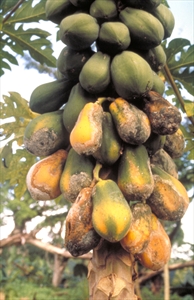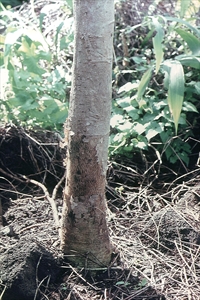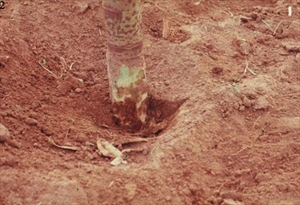Papaya fruit and root rot, Phytophthora fruit rot
Pacific Pests, Pathogens and Weeds - Online edition
Pacific Pests, Pathogens & Weeds
Papaya Phytophthora fruit & root rot (152)
Phytophthora palmivora. Note, Phytophthora nicotianae has also been recorded as the cause of this disease in e.g., Australia and Fiji. This fact sheet assumes the symptoms and management for both are similar.
Phytophthora nicotianae is recorded on papaya from Australia, Cook Islands, Federated States of Micronesia, Fiji, and French Polynesia. Phytophthora palmovora is recorded on papaya from Australia, Cook Islands, Federated States of Micronesia, Fiji, Palau, Papua New Guinea, and Samoa.
Papaya and a wide range of valuable plantation crops (e.g., coconut, cocoa) and fruit trees (e.g., avocado, citrus, breadfruit).
The disease is favoured by high soil temperatures and soils saturated with water due to heavy rainfall or poor drainage. It is especially common after long rainstorms or cyclones. Waterlogged soils starve roots of oxygen that plants need for healthy growth, and the water allows the swimming spores of the water mould to spread the disease.
Ripe and unripe fruit are infected while still attached to the stem; lower fruit are infected first. Rots develop quickly and become covered in a white growth containing spores of the water mould (Photos 1&2). Fungi and bacteria invade the fruits, increasing the rots, and causing the fruit to shrivel and fall.
Stems, especially of younger trees, also become infected through leaf and fruit scars. Rots develop, and these cause the tops of the trees to wilt and die. Rots also form at the base of the stem near soil level (Photo 3-5); in this case the decaying roots are the source of infection. These lower rots also cause leaves to turn yellow, wilt and collapse, with only a few small leaves remaining at the top of the tree (Photo 6).
Water moulds survive in the soil as thick-walled resting spores called 'chlamydospores'. When conditions are right, the chlamydospores germinate and produce spores called 'sporangia'. Yet another spore is produced inside the sporangia called 'zoospores' (see Fact Sheet no. 149), and these are capable of swimming short distances in the water between soil particles. If they reach the fine feeder roots of papaya they germinate and infect. Once inside the plant, the water mould develops more sporangia and zoospores. These symptoms are similar to those that occur on bele (see Fact Sheet no. 149).
Spores of water moulds are spread in rain splash and in wind driven rain to the lower fruit and young stems. They are also spread in surface water, and in soil on machinery and shoes.
Phytophthora is an oomycete also known as a water mould; it is not a fungus. Although Phytophthora species look like fungi, they are related to algae. The disease can be serious, causing rots of fruit, stems and roots, especially during wet weather.
Look for fruit with rapidly developing rots that are covered in white cottony growth, and also look for rots in the stem where fruit is produced. Later, look for wilting leaves as the root system decays. Look to see if the disease spreads to the roots of nearby plants as the water mould moves through the soil, or to fruit in rain splash.
CULTURAL CONTROL
Cultural control is particularly important in the management of this disease:
- Location: Do not plant papaya near cocoa blocks as Phytophyhora palmivora causes black pod and canker of cocoa and may be a source of infection for papaya.
- Soil drainage: Plant papaya only in land that is well drained. Waterlogged soil favours water moulds. Also, plant on mounds or raised beds to prevent accumulation of surface water.
- Crop rotation: Do not replant papaya in soil where Phytophthora palmivora infection occurred previously. Root rot is commonly a replant problem.
- Hygiene: Collect and burn all fallen fruit and stems of papaya trees when harvests are complete.
RESISTANT VARIETIES
None are known.
CHEMICAL CONTROL
Use chlorothalonil, copper, or mancozeb (protectants); or alternate with metalaxyl or phosphorous acid (systemics).
____________________
When using a pesticide, always wear protective clothing and follow the instructions on the product label, such as dosage, timing of application, and pre-harvest interval. Recommendations will vary with the crop and system of cultivation. Expert advice on the most appropriate pesticide to use should always be sought from local agricultural authorities.
AUTHOR Grahame Jackson
Information (and Photos 1,3,6) Gerlach WWP (1988) Plant diseases of Western Samoa. Samoan German Crop Protection Project, Deutsche Gesellschaft für Technische Zusammenarbeit (GTZ) Gmbh, Germany; and from Diseases of fruit crops in Australia (2009). Editors, Tony Cooke, et al. CSIRO Publishing; and Nelson S (2008) Phytophthora blight of papaya. Plant Disease. Cooperative Extension Service. CTAHR, University of Hawaii at Manoa. (https://www.ctahr.hawaii.edu/oc/freepubs/pdf/PD-53.pdf); and from DAF (2021) Papaya: Phytophthora diseases. Queensland Government. (https://www.daf.qld.gov.au/business-priorities/agriculture/plants/fruit-vegetable/diseases-disorders/phytophthora-diseases-in-papaya). Photo 2 Kohler F, et al. (1997) Diseases of cultivated crops in Pacific Island countries. South Pacific Commission. Pirie Printers Pty Limited, Canberra, Australia. Photos 4&5 Liberato JR, et al. (2006) Phytophthora Fruit Rot and Root Rot of Papaya (Phytophthora palmivora) PaDIL - (http://www.padil.gov.au).
Produced with support from the Australian Centre for International Agricultural Research under project PC/2010/090: Strengthening integrated crop management research in the Pacific Islands in support of sustainable intensification of high-value crop production, implemented by the University of Queensland and the Secretariat of the Pacific Community.









